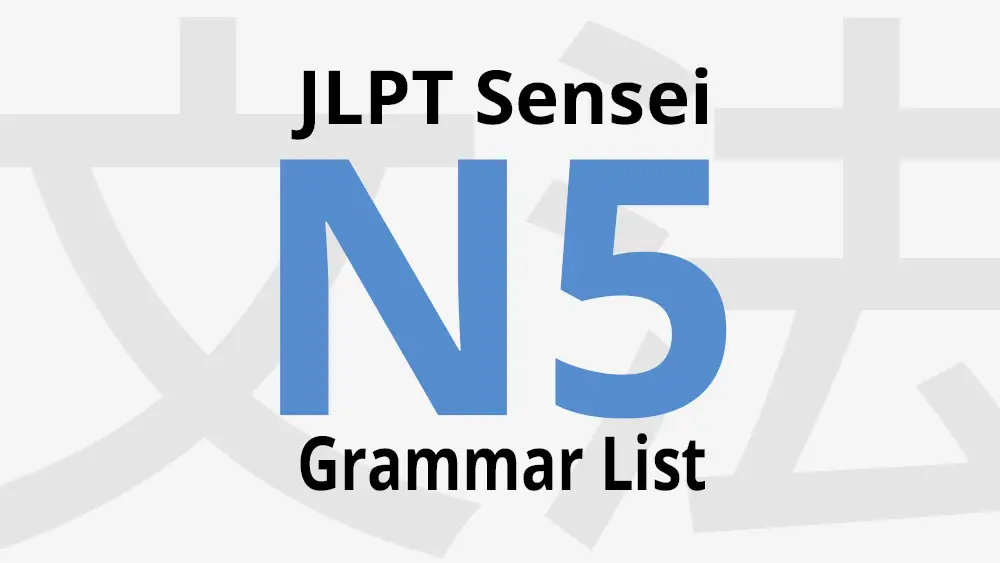Have you just started your Japanese learning journey? Have you started studying but are getting lost in the sea of material that is available out there?
I know when I started learning Japanese, there was a wide variety of material to choose from, and I worked my way through a lot of it. I consumed a lot of good textbooks, and felt like I could survive a simple conversation or two.
I started feeling a little lost since I couldn’t really see my progress. Sure, I felt like I could speak a little better, or identify a few more kanji here and there. I saw fluency as my ultimate goal, but it was hard to see the bridge to that milestone.

That was when my Japanese tutor introduce me to the JLPT. It really helped to make my progress in Japanese more concrete and visible.
And the best part was that the test had 4 steps (at that time) to it, so I could work my way to each goal post in turn.
It really started me on a journey to where I am today. Although I can’t truthfully say I’m fully fluent, I can live and work in Japan very comfortably and have been for the last 15 years.
That journey to fluency starts with the N5.
Most students can take the test after about 250~500 hours of studying the language. If you are studying specifically for the JLPT, which I don’t really recommend, you can probably take the test after about 250 hours. Meanwhile, if you are studying conversational Japanese or are studying Japanese in a more general way, you might want to try it after 500 hours of study. 250 hours is about a year of leisurely study (~21 hours a month, ~5 hours a week).
N5 Main Objective
The main goal of the N5 is for you to understand some basic conversational Japanese. Note the keyword ‘some’. If you are at an N5 level, you should be able to survive a lot of basic situations like meeting new people, shopping, or talking about your day. In other words, a lot of foundational functional language. However, you won’t be able to have more advanced conversations easily like telling a story or expressing your opinions.
Grammar
The JLPT is very grammar heavy. Most of the grammar you will use on a daily basis can be found at the N5 level. This includes things like the basic particles (は, が, を, etc…) needed to mark the different parts of the sentence. It also includes the basic tenses (past and non-past forms) as well as polite / masu form and casual / dictionary form of verbs.
The JLPT does not publish any official lists of grammar points that will appear on the test. However, generally speaking, the grammar points that are covered are about the same as what was covered in the pre-2010 tests, which did have a published list of grammar points. You can find lists of the grammar points on various sites around the web, including JLPT Sensei’s (very well-organized) JLPT N5 grammar list on this site.

Be sure to not only study for the grammar on the test, but also work your way through a drill book so that you can get a feel for what the real test is going to be like.
The test will check your understanding of grammar points in comparison to other similar grammar points, so it is important to know the differences between the different particles that the test will go over. For instance, know when to use the で particle, which can mark a location where something takes place, and when to use the に particle, which can also mark a location, but one that is being traveled to.
You can practice a lot of these more difficult questions in the JLPT Study Guide for the N5.
Kanji and Vocabulary
The N5 is relatively light on the kanji you need to know, which is around 100 (See JLPT Sensei’s JLPT N5 Kanji List). You can use an SRS program like Anki or Memrise to drill these on a daily basis and master them before the test.
Although you will not be asked to actually write the kanji on the test, some students find it useful to practice writing the kanji. If you are better learning things ‘with your hands’ or are more active in general, this is a good strategy to keep your mind alert and focused on the kanji you are studying.
A good paid alternative for studying kanji is WaniKani. This site is really well put together and just simply works seamlessly. It has quickly become the place to learn Japanese kanji on the web.
One disadvantage is that it doesn’t follow the JLPT kanji levels exactly. It uses a different system based on simplicity, usefulness, and kanji radicals. Still, the sooner you can master kanji the sooner you can start reading native materials and getting real practice with the language. So if you are interested in mastering Japanese this is a good place to start.
Reading and Listening
The listening for the JLPT is not particularly difficult, but it might not be the kind of listening that you are used to. In a regular conversation you would normally be able to ask questions, but that is not the case on the JLPT. You only get one chance to listen, so you must stay focused for the entire section. That might be the hardest skill to master for this section. A lot of the questions will attempt to trick you into choosing the wrong answer. A good number of the questions will seem to give you the answer at the beginning only to make a small change to it later, so be sure to keep listening until the end.
The reading for the test may also be difficult since a lot of learners might not have experience with reading Japanese at this level. It is also fairly difficult to find good reading practice that is appropriate for the test. The only way to get good reading practice is to pick up a reading practice book for this level.

N5! Huh! What is it good for?
The N5 probably won’t put you on the short list for any jobs in Japan, but you shouldn’t write it off. It is a good way to show that you have an interest in Japanese and are serious about continuing your studying. Having a passing grade shows that you care enough about learning Japanese, that you actually paid good money, woke up, got dressed, and sat through a couple of hours of testing. Not everyone is willing to do that, which can separate you from the pack of other job candidates.
It’s also possible to study for the N5 and not take the test. Yes, shocking I know.
So, why would you do this? Why would you spend the time and effort and not sit the test?
You would do this in order to keep your studies well-rounded and so you can ease your way up to the higher levels. Reading in Japanese is extremely useful, but a lot of reading books for Japanese start at a much more advanced level. That’s a bit like jumping into open water on your first day of swimming class. And, it can be incredibly difficult to learn to swim if you start off that way.
So that is why it is good to take steps and learn good reading and listening habits early before you get into bad habits. Mastering those good habits in the kiddie pool, and then gradually move your way up to more difficult challenges.
Are you ready to start your Japanese journey? Prepare for the N5 with the JLPT Study Guide for the N5, and take the test!


